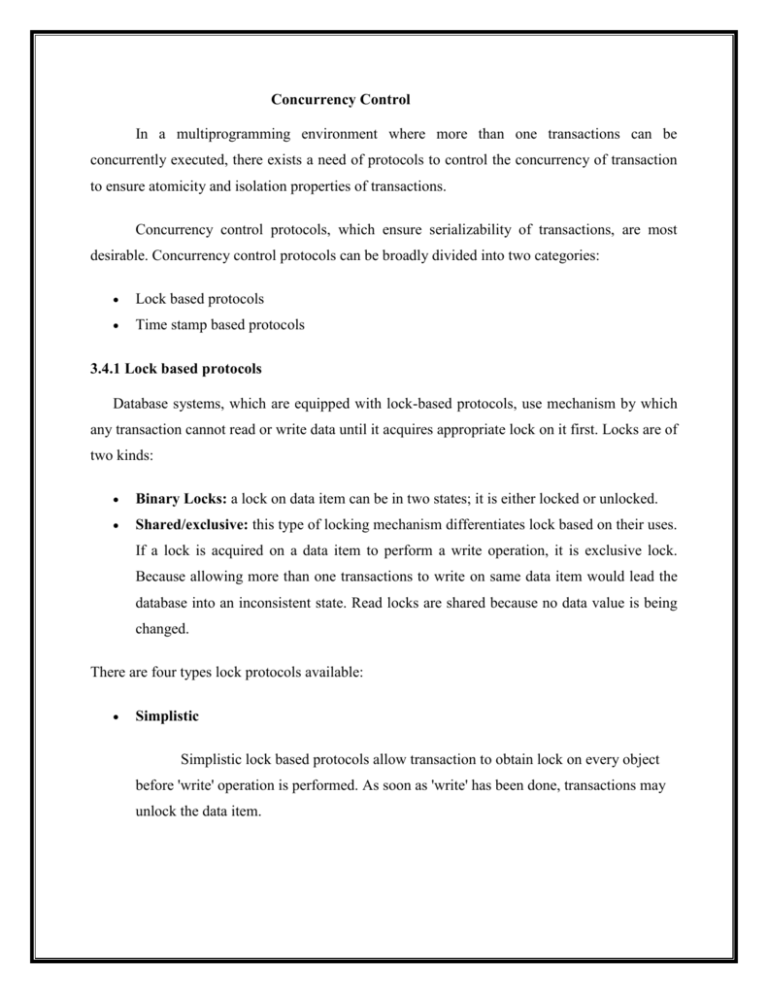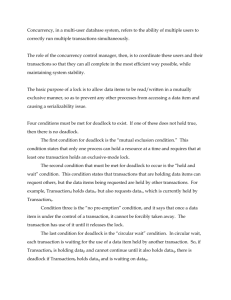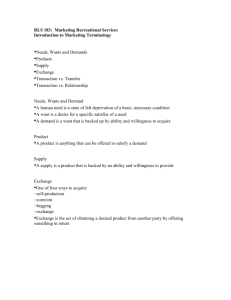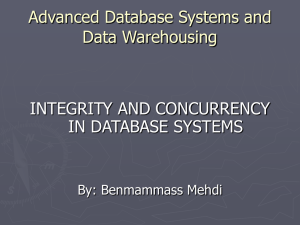Concurrency Control
advertisement

Concurrency Control
In a multiprogramming environment where more than one transactions can be
concurrently executed, there exists a need of protocols to control the concurrency of transaction
to ensure atomicity and isolation properties of transactions.
Concurrency control protocols, which ensure serializability of transactions, are most
desirable. Concurrency control protocols can be broadly divided into two categories:
Lock based protocols
Time stamp based protocols
3.4.1 Lock based protocols
Database systems, which are equipped with lock-based protocols, use mechanism by which
any transaction cannot read or write data until it acquires appropriate lock on it first. Locks are of
two kinds:
Binary Locks: a lock on data item can be in two states; it is either locked or unlocked.
Shared/exclusive: this type of locking mechanism differentiates lock based on their uses.
If a lock is acquired on a data item to perform a write operation, it is exclusive lock.
Because allowing more than one transactions to write on same data item would lead the
database into an inconsistent state. Read locks are shared because no data value is being
changed.
There are four types lock protocols available:
Simplistic
Simplistic lock based protocols allow transaction to obtain lock on every object
before 'write' operation is performed. As soon as 'write' has been done, transactions may
unlock the data item.
Pre-claiming
In this protocol, a transactions evaluations its operations and creates a list of data
items on which it needs locks. Before starting the execution, transaction requests the
system for all locks it needs beforehand. If all the locks are granted, the transaction
executes and releases all the locks when all its operations are over. Else if all the locks
are not granted, the transaction rolls back and waits until all locks are granted.
3.4.2 Two Phase Locking - 2PL
This locking protocol is divides transaction execution phase into three parts. In the first
part, when transaction starts executing, transaction seeks grant for locks it needs as it executes.
Second part is where the transaction acquires all locks and no other lock is required. Transaction
keeps executing its operation. As soon as the transaction releases its first lock, the third phase
starts. In this phase a transaction cannot demand for any lock but only releases the acquired
locks.
Two phase locking has two phases, one is growing; where all locks are being acquired by
transaction and second one is shrinking, where locks held by the transaction are being released.
To claim an exclusive (write) lock, a transaction must first acquire a shared (read) lock
and then upgrade it to exclusive lock.
3.4.3 Time stamp based protocols
The most commonly used concurrency protocol is time-stamp based protocol. This
protocol uses either system time or logical counter to be used as a time-stamp.
Lock based protocols manage the order between conflicting pairs among transaction at
the time of execution whereas time-stamp based protocols start working as soon as transaction is
created.
Every transaction has a time-stamp associated with it and the ordering is determined by
the age of the transaction. A transaction created at 0002 clock time would be older than all other
transaction, which come after it. For example, any transaction 'y' entering the system at 0004 is
two seconds younger and priority may be given to the older one.
In addition, every data item is given the latest read and write-timestamp. This lets the system know, when
last read was and write operation made on the data item
Time-stamp ordering protocol
The timestamp-ordering protocol ensures serializability among transaction in their
conflicting read and writes operations. This is the responsibility of the protocol system that the
conflicting pair of tasks should be executed according to the timestamp values of the
transactions.
Time-stamp of Transaction Ti is denoted as TS(Ti).
Read time-stamp of data-item X is denoted by R-timestamp(X).
Write time-stamp of data-item X is denoted by W-timestamp(X).
Timestamp ordering protocol works as follows:
If a transaction Ti issues read(X) operation:
o
If TS(Ti) < W-timestamp(X)
o
If TS(Ti) >= W-timestamp(X)
o
Operation rejected.
Operation executed.
All data-item Timestamps updated.
If a transaction Ti issues write(X) operation:
o
If TS(Ti) < R-timestamp(X)
o
If TS(Ti) < W-timestamp(X)
o
Operation rejected.
Operation rejected and Ti rolled back.
Otherwise, operation executed.
3.4.5 Thomas' Write rule:
This rule states that in case of:
If TS(Ti) < W-timestamp(X)
Operation rejected and Ti rolled back. Timestamp ordering rules can be modified to make the
schedule view serializable. Instead of making Ti rolled back, the 'write' operation itself is ignored.
n a multi-process system, deadlock is a situation, which arises in shared resource
environment where a process indefinitely waits for a resource, which is held by some
other process, which in turn waiting for a resource held by some other process.
For example, assume a set of transactions {T0, T1, T2, ...,Tn}. T0 needs a resource X to
complete its task. Resource X is held by T1 and T1 is waiting for a resource Y, which is
held by T2. T2 is waiting for resource Z, which is held by T0. Thus, all processes wait for
each other to release resources. In this situation, none of processes can finish their task.
This situation is known as 'deadlock'.
Deadlock is not a good phenomenon for a healthy system. To keep system deadlock free few methods can
be used. In case the system is stuck because of deadlock, either the transactions involved in deadlock are
rolled back and restarted.









